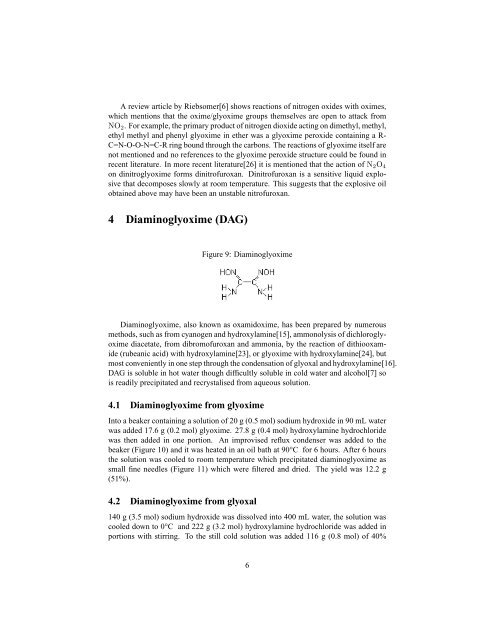Glyoxime, Diaminofurazan and some Energetic Derivatives, by AXT
Glyoxime, Diaminofurazan and some Energetic Derivatives, by AXT
Glyoxime, Diaminofurazan and some Energetic Derivatives, by AXT
You also want an ePaper? Increase the reach of your titles
YUMPU automatically turns print PDFs into web optimized ePapers that Google loves.
A review article <strong>by</strong> Rieb<strong>some</strong>r[6] shows reactions of nitrogen oxides with oximes,<br />
which mentions that the oxime/glyoxime groups themselves are open to attack from<br />
NO2. For example, the primary product of nitrogen dioxide acting on dimethyl, methyl,<br />
ethyl methyl <strong>and</strong> phenyl glyoxime in ether was a glyoxime peroxide containing a R-<br />
C=N-O-O-N=C-R ring bound through the carbons. The reactions of glyoxime itself are<br />
not mentioned <strong>and</strong> no references to the glyoxime peroxide structure could be found in<br />
recent literature. In more recent literature[26] it is mentioned that the action of N2O4<br />
on dinitroglyoxime forms dinitrofuroxan. Dinitrofuroxan is a sensitive liquid explosive<br />
that decomposes slowly at room temperature. This suggests that the explosive oil<br />
obtained above may have been an unstable nitrofuroxan.<br />
4 Diaminoglyoxime (DAG)<br />
Figure 9: Diaminoglyoxime<br />
Diaminoglyoxime, also known as oxamidoxime, has been prepared <strong>by</strong> numerous<br />
methods, such as from cyanogen <strong>and</strong> hydroxylamine[15], ammonolysis of dichloroglyoxime<br />
diacetate, from dibromofuroxan <strong>and</strong> ammonia, <strong>by</strong> the reaction of dithiooxamide<br />
(rubeanic acid) with hydroxylamine[23], or glyoxime with hydroxylamine[24], but<br />
most conveniently in one step through the condensation of glyoxal <strong>and</strong> hydroxylamine[16].<br />
DAG is soluble in hot water though difficultly soluble in cold water <strong>and</strong> alcohol[7] so<br />
is readily precipitated <strong>and</strong> recrystalised from aqueous solution.<br />
4.1 Diaminoglyoxime from glyoxime<br />
Into a beaker containing a solution of 20 g (0.5 mol) sodium hydroxide in 90 mL water<br />
was added 17.6 g (0.2 mol) glyoxime. 27.8 g (0.4 mol) hydroxylamine hydrochloride<br />
was then added in one portion. An improvised reflux condenser was added to the<br />
beaker (Figure 10) <strong>and</strong> it was heated in an oil bath at 90°C for 6 hours. After 6 hours<br />
the solution was cooled to room temperature which precipitated diaminoglyoxime as<br />
small fine needles (Figure 11) which were filtered <strong>and</strong> dried. The yield was 12.2 g<br />
(51%).<br />
4.2 Diaminoglyoxime from glyoxal<br />
140 g (3.5 mol) sodium hydroxide was dissolved into 400 mL water, the solution was<br />
cooled down to 0°C <strong>and</strong> 222 g (3.2 mol) hydroxylamine hydrochloride was added in<br />
portions with stirring. To the still cold solution was added 116 g (0.8 mol) of 40%<br />
6
















